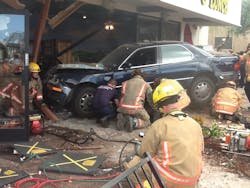The Fire Service PIO: Using Social Media For PIO Duties
A new tool available for use by public information officers (PIOs) is social media. Used mostly by younger people, it is becoming more widely used by all age groups as people become more acquainted with it and understand it. I must admit I was intimidated with it at first, but have come to use it more and more.
To use social media more effectively, I am using a smartphone and tablet that are designed for ease of use. Each also has a camera for photo and video capture and an audio recording app. Each of these can be used with the dissemination of my messages.
Although many social media outlets are available, the three I use is Twitter, YouTube and Facebook. For this column I am going to cover the use of Twitter and YouTube.
Using Twitter
Twitter is a way to easily put out short messages to a group of people who elected to “follow” you. I have been using email or digital paging systems to send messages to the media since 1992. It was a very fast way to get the word out, especially during emergencies, and recipients knew it was coming from the official source. I had to program each email address or pager number into the program and many times I was adding, deleting or changing numbers, which sometimes became troublesome. It also went out to only a limited number of people who knew about it.
With Twitter people add or delete themselves. All you do is provide the information. You can use a cell phone, tablet or computer to send out your message. This way you can do it from just about anywhere at any time. Your message is limited to 140 characters, so make your message brief, concise and to the point. Many times, I abbreviate, which saves space. As you read other people’s “tweets” you will become more familiar with the language that is used by “tweeters.” Most of the time, I will send a tweet to advise of an incident and what is currently being done. Later, I will send a tweet to advise how it ended up. At larger incidents I sometimes take a photo with my smartphone/tablet and tweet it out also. That way people can see what is going on “live,” which makes it more interesting.
Here are some examples of tweets I have sent:
sample tweets:
• 21 Imperial Av outside fire in rear alley started by wires down, hvy fire in alley on arrival-no inside bldgs, have knockdown. PIO1
• Vacant dbl-wide mobile home fire is OUT at Millennium MHP 830 N. Lamb Bl, no extension, no inj’s, under investg’n, some units in service PIO1
• Valley Dr at Melody Ln vacant house fully involved, defensive mode, limited water in area, PIO enroute. PIO1
YouTube & the PIO
With YouTube you can upload video of incidents or activities and it make it available for people to see what your department is doing. If the media is not available, it provides them with material to use. There is even an app available that permits me to edit my videos into useable material while on scene and upload it to YouTube. By the time I prepare my media release after the incident, I can provide links to my photos and YouTube so the media can use the visual material along with the media release.
With photos or video there are certain guidelines you should use. Do not show images of people who are injured or deceased. This could be a violation of the Health Insurance Portability and Accountability Act (HIPAA) and could offend family members. Take photos that show people being extricated from a vehicle accident or loaded into an ambulance, but do so only if they cannot be identified. People are more interested in action photos of flames, smoke or first responders in action. Notice how the media does it when you look at the paper or watch the news. That is the material they are looking for because they know that is what people want to see.
Disseminated material that is “official” and you are absolutely positive it is correct. Never speculate or give opinions. A PIO’s function is to release official and factual information. You are providing the information through social media. If it is incorrect, you cannot blame the media, you are the outlet.
Social media is becoming widely accepted and used more and more each day. It is an exciting new tool for PIOs to use. What I have learned is you only get good at it if you use it daily so you get the practice. Put out safety messages, if nothing else. That way, when you are at an incident and want to get information out fast (especially life-saving information), you will be able to with ease.
You can visit my Twitter at LasVegasFD or FirePEIO or my YouTube at pio1lv.
TIMOTHY R. SZYMANSKI has been in the fire service for 41 years and is the Public Education & Information Officer (PEIO) for Las Vegas, NV, Fire & Rescue. He has worked in every position from firefighter/paramedic to fire chief. Szymanski is a Nevada-certified Fire Service Master Instructor and holds national and state certifications in many areas of the fire service. He has received numerous awards, including the 2008 Liberty Mutual National Firemark Award for Community Education and the Community Service Award from the Nevada Broadcasters Association. He was the Fire & Emergency PIO during the 1996 Olympics in Atlanta. His website is www.firepeio.com and Twitter at firepeio.






